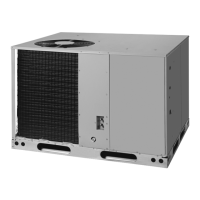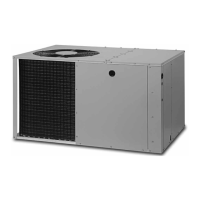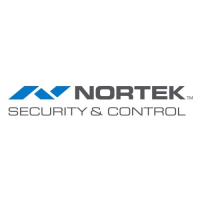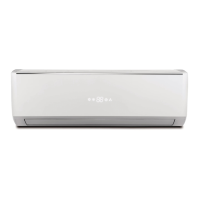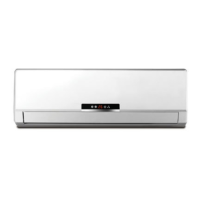7
Figure 5. Supply Damper
AUTOMATIC DAMPER IS CLOSED
WHEN HEAT PUMP IS OFF
Figure 4. Return Air Box
Locating & Installing the Supply Damper(s)
When locating the supply damper(s), carefully check
floor joists and frame members that could interfere with
the installation of the damper or flexible duct. Ideally, the
damper (Figure 5) should be located in the bottom of the
main duct, forward of center of the home, at least three
feet from the nearest register. The round supply opening
in the slanted side of the damper should face the side of
the home where the heat pump is located.
1. Locate the center of the heat duct by cutting a small hole
in the fiberboard below the duct at the desired location.
2. Cut a hole approximately 3/4” larger than the damper
opening in the fiberboard.
3. Cut a 9-1/8” x 13-1/8” hole in the duct and bend over
all tabs flat on the inside of the heat duct.
4. Insert the damper into the duct and bend over all tabs
flat on the inside of the heat duct.
5. Seal the opening between the fiberboard and damper
or flexible duct.
Figure 6. Drain Trap
Elbow
P-Trap
1. Thread the elbow provided with the unit into the drain
connection until hand tight.
2. Connect the condensate tubing onto the fitting, forming
a trap (Figure 6) near the drain connection.
3. Route the condensate tube from the trap to a suitable
drain. NOTE: For proper drainage, make sure the trap
is level to the ground and tubing outlet is below trap
level.
Condensate Drainage
A 3/4” condensate fitting extends out of the side of the
unit as shown in Figure 6. The drain trap, shipped in the
electrical compartment, must be installed to prevent water
from collecting inside the unit.
ELECTRICAL CONNECTIONS
WARNING:
To avoid electric shock, personal injury, or death,
turn off the electric power at the disconnect
or the main service panel before making any
electrical connections.
• Electrical connections must be in compliance with
all applicable local codes and ordinances, and with
the current revision of the National Electric Code
(ANSI/NFPA 70).
• ForCanadian installationsthe electrical connections
and grounding shall comply with the current Canadian
Electrical Code (CSA C22.1 and/or local codes).
Pre-Electrical Checklist
√ Verify that the voltage, frequency, and phase of the
supply source match the specifications on the unit rating
plate.
√ Verify that the service provided by the utility is sufficient
to handle the additional load imposed by this equipment.
Refer to the unit wiring label for proper high and low
voltage wiring.
√ Verify factory wiring is in accordance with the unit wiring
diagram (Figures 9 - 11, pages 20 - 22). Inspect for
loose connections.
LineVoltage
• Itisrecommendedthatthelinevoltagetotheunitbe
supplied from a dedicated branch circuit containing the
correct fuse or circuit breaker for the unit.
• An electrical disconnect must be located within sight
of and readily accessible to the unit. This switch shall

